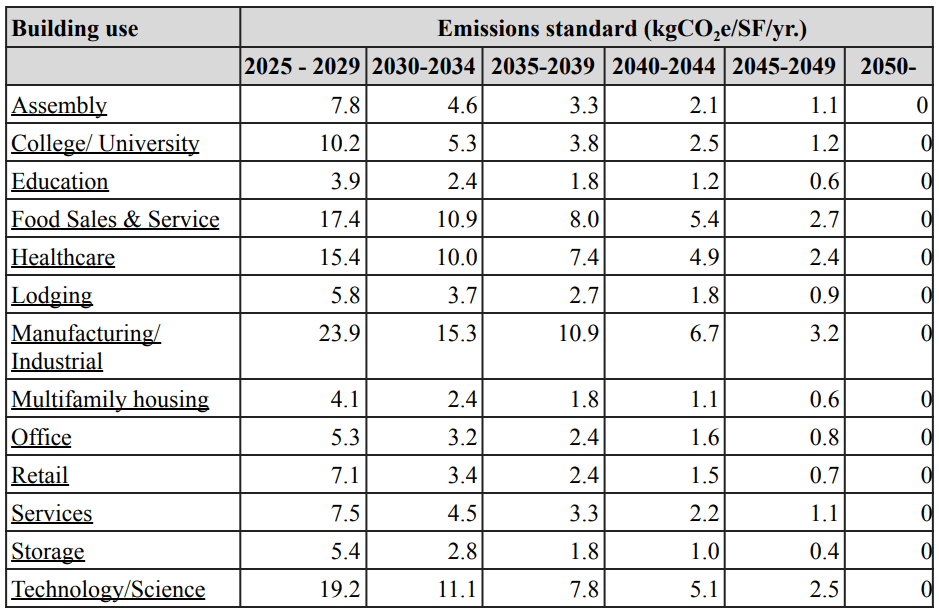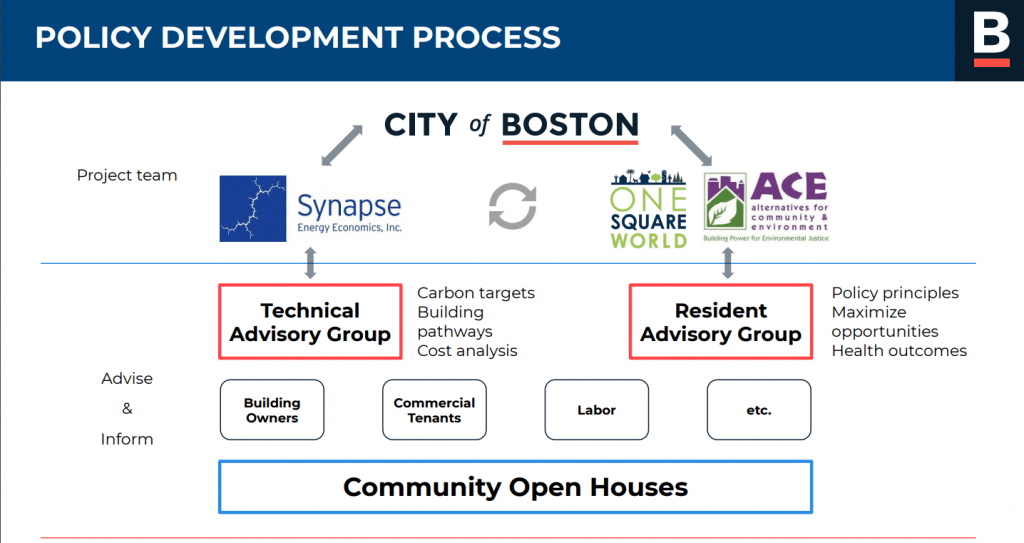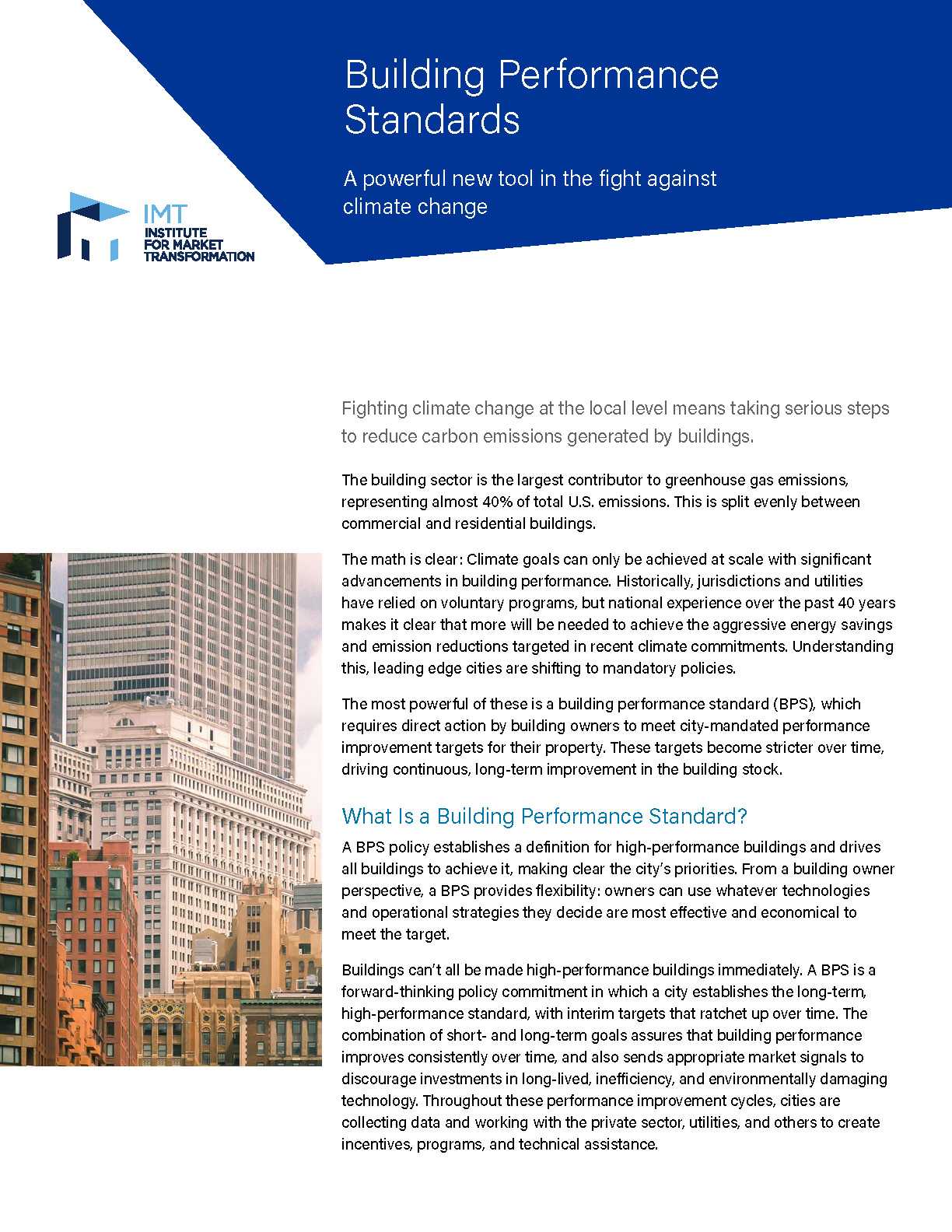With the Building Emissions Reduction and Disclosure Ordinance, Boston is poised to become the latest city to adopt a building performance standard. Cities across the country are using these ambitious policies to take significant action in reducing their carbon emissions.
Today, Boston City Council President Pro Tempore Matt O’Malley introduced the Building Emissions Reduction and Disclosure Ordinance (BERDO), an update to the Building Energy Reporting and Disclosure Ordinance, which Boston adopted in 2013. While the earlier “BERDO” was primarily a building energy benchmarking, transparency, and audit ordinance, this proposed update to BERDO would put Boston on the path for meeting its carbon neutrality by 2050 commitments. With this ordinance, Boston seeks to join the ranks of other leading jurisdictions in adopting a building performance standard such as New York, St Louis, Washington, D.C., the state of Washington, and, most recently, the state of Colorado.
Why Performance Standards
Jurisdictions like Boston that want to lead on climate change action are looking to building performance standards (BPS) as a key strategy for reducing their greenhouse gas (GHG) emissions. Buildings account for over 70% of Boston’s annual GHG emissions, with the majority of those emissions originating from the largest commercial and multifamily residential buildings in the city. For Boston to achieve its climate goals of 50% GHG reduction by 2030 from a 2005 baseline, and carbon neutrality by 2050, significant decarbonization work is needed for these large existing buildings.
BPS policies require that buildings meet specific performance targets including energy targets. BPS typically drives building owners and managers to find innovative strategies to improve their energy efficiency, electrify their buildings, and otherwise decarbonize their buildings in meeting these targets. By focusing in on reducing this key driver of energy demand, BPS policies can assist the whole economy in transitioning to decarbonized sources of energy. There are also other critical co-benefits for BPS policies, including lowering energy cost burdens, improving indoor and outdoor air quality, and spurring the creation of jobs in the construction and retrofit sectors.
Features of Boston’s Policy
The newly-introduced BERDO acts as its BPS policy. If enacted, it will require that all buildings containing 20,000 or more square feet of gross floor area meet a series of emissions intensity targets starting in 2025 and ending at carbon neutrality in 2050. The carbon emissions targets will be measured as kilograms of carbon dioxide equivalent (kgCO2e) per square foot per year, with different targets being required each year based on each building’s uses. For instance, starting in 2025 an office building will be permitted to emit no more than 5.3 kgCO2e per square foot per year, 3.2 starting 2030, 2.4 starting in 2035, all the way down to 0 kgCO2e per square foot per year in 2050 and every year thereafter.
Emissions Targets for Boston’s BPS

The policy contains a number of features to allow for flexibility for covered buildings. Emission standards for mixed-use buildings will be calculated as a weighted average based on the square footage of each use. With approval from the city, each owner of multiple buildings can comply based on its portfolio-wide emissions, but every portfolio will still need to reach the zero emissions target by 2050.
As an alternative compliance option, each owner can apply for an Individual Compliance Schedule, whereby the owner will be in compliance if it achieves a 50% reduction in GHG emissions by 2030 and 100% by 2050 from a 2018 or later baseline for its building or portfolio of buildings. Offsite renewable electricity purchase is an available compliance pathway to help encourage electrification and provide more flexibility, but the renewable energy must meet specific Massachusetts State criteria or other stringent power purchasing agreement requirements.
While Boston’s BPS policy does not account for the time of use of electricity, the City recognizes that electricity demand management is critical to reliability, controlling supply-side costs, and achieving the City’s climate commitments. The City will, therefore, continue to monitor utility and building owner capacity with an eye to whether the policy should account for time of use in the future.
Owners of buildings that don’t meet their emissions targets, or do not have an approved Hardship Compliance Plan, can pay an Alternative Compliance Payment equal to $234 per metric ton of CO2e in excess of each building’s target. The resulting revenue will be used for an Equitable Emissions Investment Fund designed to help environmental justice populations by upgrading relevant buildings to improve energy performance. To ensure that the Equitable Emissions Investment Fund is utilized to benefit these communities, the bill creates a Review Board made up of majority of members proposed by environmental justice and community-based organizations. The Board will administer the fund and ensure that marginalized voices have direct power over key features of the policy.
Boston’s Equitable Policy Development Process
The Boston BPS policy was developed by a team of city staff, stakeholders, and community organizations, with the assistance of expert consultants, including IMT and other partners in the Bloomberg American Cities Climate Challenge. Following the release of the Carbon Free Boston analysis report that detailed pathways to meeting Boston’s carbon neutrality goals by 2050, the city launched a stakeholder engagement process to update its climate action plan. A major recommendation from community and stakeholders was for Boston to adopt a BPS and more rigorously address decarbonization in its largest buildings.
This commitment to adopt a BPS policy was written into the City’s 2019 Climate Action Plan update. During 2020, Boston’s Environment Department staff (of whom I was one) engaged in a two-pronged engagement process. The first was a technical advisory group, convened by Synapse Energy Economics, bringing in local expertise in the building science, construction, retrofit, and management sectors to advise on pathways and costs for building decarbonization. The second was a community advisory group, involving One Square World, Alternatives for Community and Environment, and other local community-based organizations. The community advisory group convened residents of multifamily buildings that will be impacted by the BPS policy to advise on key policy elements. In addition, Environment Department staff convened many stakeholder working groups to inform on the policy, including a commercial tenant group facilitated by IMT.

What Can Cities Learn From Boston
While Boston took a different approach in terms of metrics compared to IMT’s model BPS ordinance, the Boston case exemplifies many key principles that IMT believes are critical for effective BPS policies and their development.
Boston centered equity as a core policy goal in designing its BPS ordinance. Environmental justice community members and community-based organizations were involved in the policy development process from the beginning. The effects of this engagement can be seen in the creation of the Equitable Emissions Investment Fund and Review Board that gives these community partners direct control and oversight of the policy and the equitable distribution of carbon abatement funds.
Boston’s BPS ordinance functions as a platform for regulating aspects of building performance that relate to the city’s priorities. The emissions targets are designed to assist Boston in meeting its 2030 and 2050 climate change goals. In doing so Boston’s BPS policy includes long-term visibility to enable building owners to plan carbon abatement capital improvements for the next three decades. Lastly, Boston’s BPS offers appropriate flexibility by being technology agnostic and allowing for the market to find innovative pathways to meet the targets.
Personally, I am incredibly proud of being part of the team at the Environment Department that created such a groundbreaking policy, and I am optimistic that IMT can continue to scale these policies in coming years

